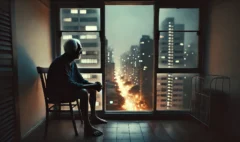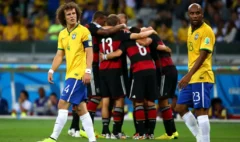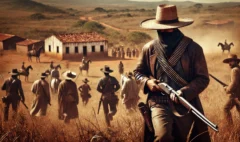Is “City of God” a Disturbing Film?
Is “City of God” a Disturbing Film?
Yes, “City of God” is a Disturbing Film
The goal of directors Fernando Meirelles and Kátia Lund, along with screenwriter Bráulio Mantovani, was to create an unsettling experience when adapting Paulo Lins’ novel to the big screen.
The plot follows the creation, growth, and development of the Cidade de Deus (City of God) community over several decades, showing how crime emerged, expanded, and evolved there. The protagonist, Buscapé, guides us through these transformations. Although Dadinho/Zé Pequeno is the most iconic character, Buscapé plays the essential role of narrator, offering insights into the events unfolding in the community. His voiceover narration is not a lazy storytelling device but rather a powerful choice that provides viewers with a broader perspective.
Buscapé, Played by Alexandre Rodrigues
Buscapé dreams of becoming a professional photographer. Like a photographer, he captures and conveys the realities of City of God. His presence is crucial to the story—without him, the narrative would be fragmented. He serves as an observer amid chaos, witnessing and documenting the events around him.
One of the film’s most memorable scenes involves Buscapé attempting to catch a chicken. The spinning camera around him effectively symbolizes the chaos, making this scene one of Brazilian cinema’s most iconic moments.
Zé Pequeno, Played by Leandro Firmino
In “City of God,” Dadinho/Zé Pequeno is the main antagonist, yet the film does not follow a conventional hero-villain dynamic. Throughout the story, Zé Pequeno shows little regard for Buscapé, often forgetting his name, highlighting his indifference toward ordinary residents.
This narrative approach breaks away from traditional protagonist-antagonist conflicts. Instead, “City of God” presents the harsh reality of urban life, where Buscapé represents the majority of residents trying to live their daily lives without getting entangled in crime.
Why is “City of God” Disturbing?
The film is disturbing for many viewers due to its frequent profanity and graphic violence. These elements may cause discomfort, especially for those unfamiliar with the harsh realities of places like City of God.
However, the film critically examines the cycle of violence that has become a norm in the community. For Buscapé and others, violence is a part of everyday life, leading to a sense of desensitization. Even hardworking, law-abiding citizens in the neighborhood become accustomed to it, often out of fear of retaliation.
The Film’s Flawless Narrative Structure
Depicting the history of City of God over such a long period with numerous characters demonstrates the filmmakers’ deep understanding of storytelling. Every detail in the film serves a purpose. Just as life in a favela is highly complex, so is the film’s microcosm. Despite the multitude of characters and interconnected subplots, the narrative remains cohesive and engaging, never feeling overwhelming or disorganized.
This intricate storytelling makes “City of God” incredibly dynamic. The film leaves audiences in awe, thanks to the brilliant choices made by the screenwriters, directors, editors, and production team. “City of God” is the result of an extraordinary alignment of creative decisions.
The Cinematic Brilliance of “City of God”
Kátia Lund and Fernando Meirelles’ Direction
Another remarkable aspect of the film is its cinematography. The color palette and camera techniques shift throughout the movie to reflect the evolving atmosphere. Initially, the tones are warm and earthy, emphasizing the isolation of City of God from the wealthy parts of Rio de Janeiro. Toward the end, the colors become darker, mirroring the growing chaos.
At the beginning, the camera work is more stable and smooth. As the story progresses and disorder intensifies, the filmmakers opt for handheld camera techniques. This visual style gives the film a documentary-like realism. Interestingly, the final scene of Zé Pequeno was filmed by Alexandre Rodrigues (Buscapé) himself, despite having no cinematography experience. The shaky footage results from both his lack of control over the camera and the directors’ stylistic choice, making the scene even more impactful.
Perhaps this raw, immersive approach is what makes “City of God” even more unsettling compared to other films that tackle violence.
The Cast: A Perfect Blend of Professionals and Amateurs
One of the film’s greatest strengths is its casting. The mix of professional and amateur actors, both adults and children, was a stroke of genius. The performances are uniformly strong, reinforcing the film’s realism.
From iconic lines to the heartbreaking moment when a child is shot in the foot, every scene carries weight. While the cast includes seasoned actors such as Babu Santana, Gero Camilo, Matheus Nachtergaele, and Seu Jorge, “City of God” also introduced standout performances from Alexandre Rodrigues, Douglas Silva, Phellipe Haagensen, Darlan Cunha, Jonathan Haagensen, Leandro Firmino, Roberta Rodrigues, Renato de Souza, Rubens Sabino, and many others.
A Timeless Classic of Brazilian Cinema
Since its release in 2002, “City of God” has been widely acclaimed as one of Brazil’s greatest films. Every element—direction, cinematography, screenplay, production design, art direction, costume design, editing, and sound—is executed flawlessly.
“City of God” is a dramatic film, but it also incorporates elements of action and crime thriller. It is disturbing, not because it exaggerates violence, but because, for many privileged viewers, it remains a work of fiction. However, for millions of Brazilians living in favelas, “City of God” reflects their everyday reality.
The True Disturbance Lies in the Film’s Reflection
Ultimately, the most unsettling aspect of “City of God” is not the film itself, but the harsh truth it exposes about social inequality and violence in Brazil. That reflection is what truly makes it a disturbing masterpiece.
Learn Portuguese the Brazilian Way! 🇧🇷✨
At The Brazilian Ways, we believe language learning should be fun, immersive, and deeply connected to culture. Our unique courses help you speak Portuguese naturally while experiencing Brazil through its music, films, literature, and dance.
🎶 The Brazilian Music Club – Learn Portuguese through the rhythm and lyrics of Brazilian music.
🎬 The Movie Club – Improve your Portuguese while exploring the best of Brazilian cinema.
📖 The Short Story Club – Enhance your skills by diving into Brazilian literature.
💃 Portuguese for Zouk – Connect with the Zouk dance community while learning Portuguese.
✨ Join a vibrant community of learners and experience Brazil through language!
👉 Explore our programs and start today! 🚀

















